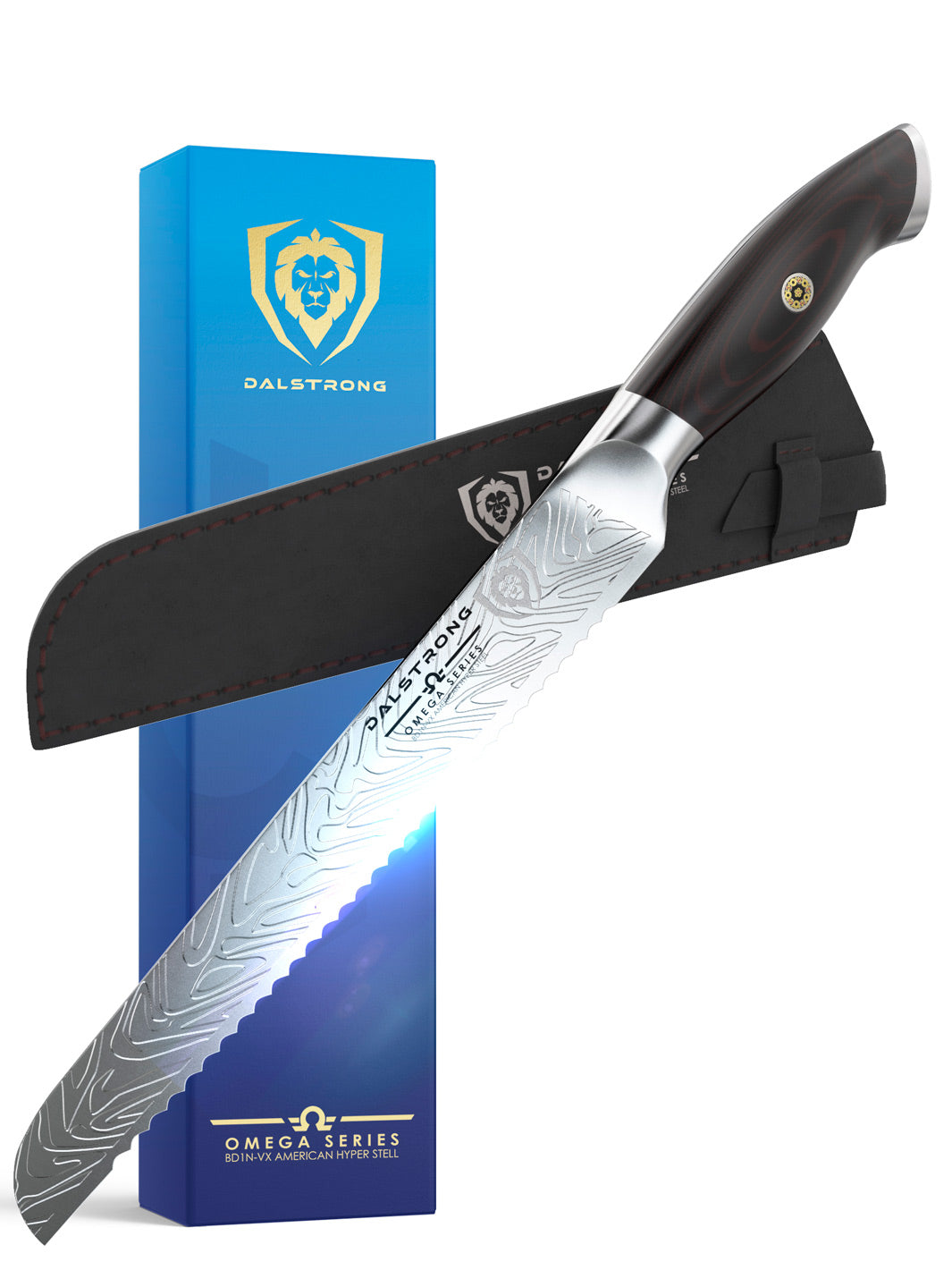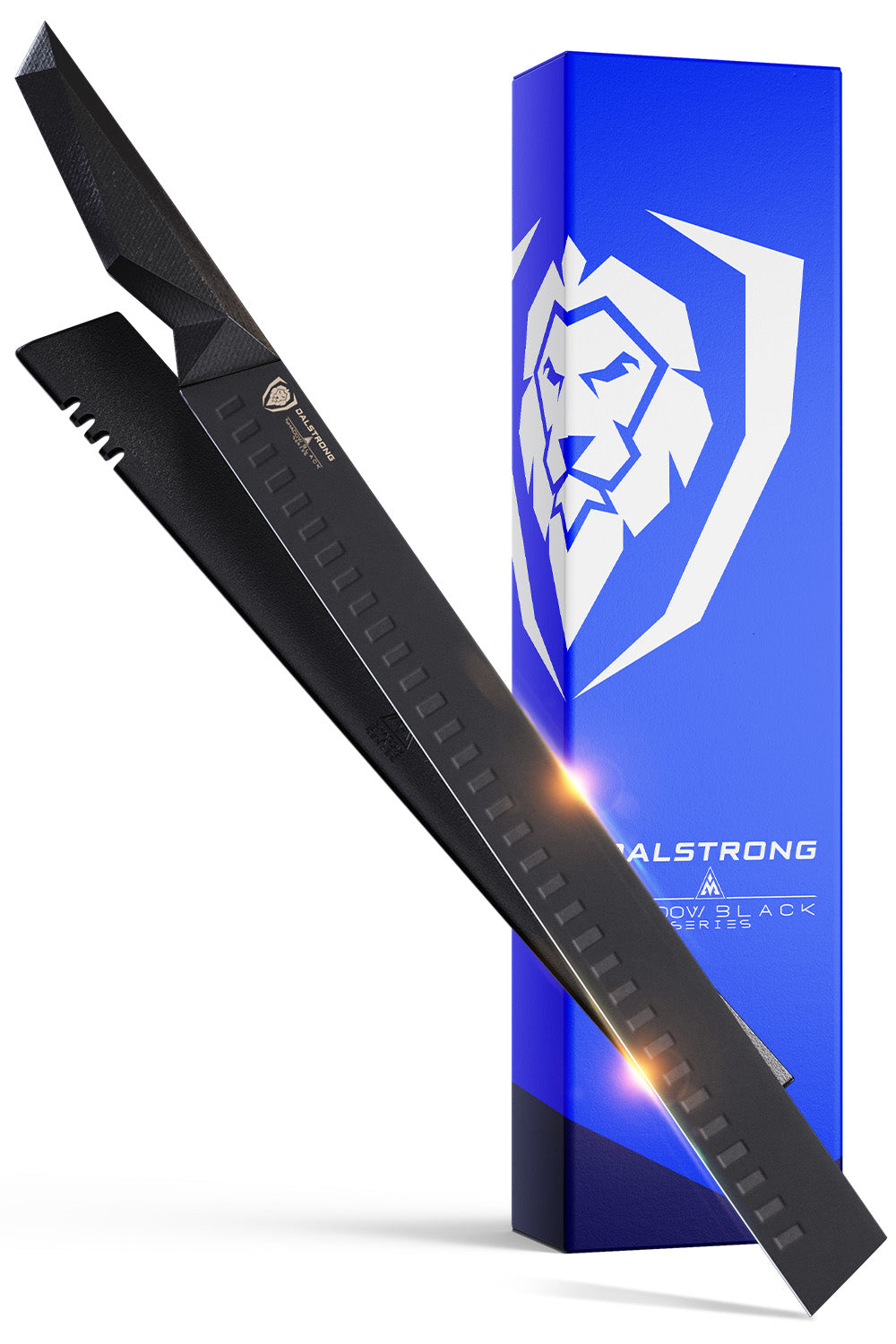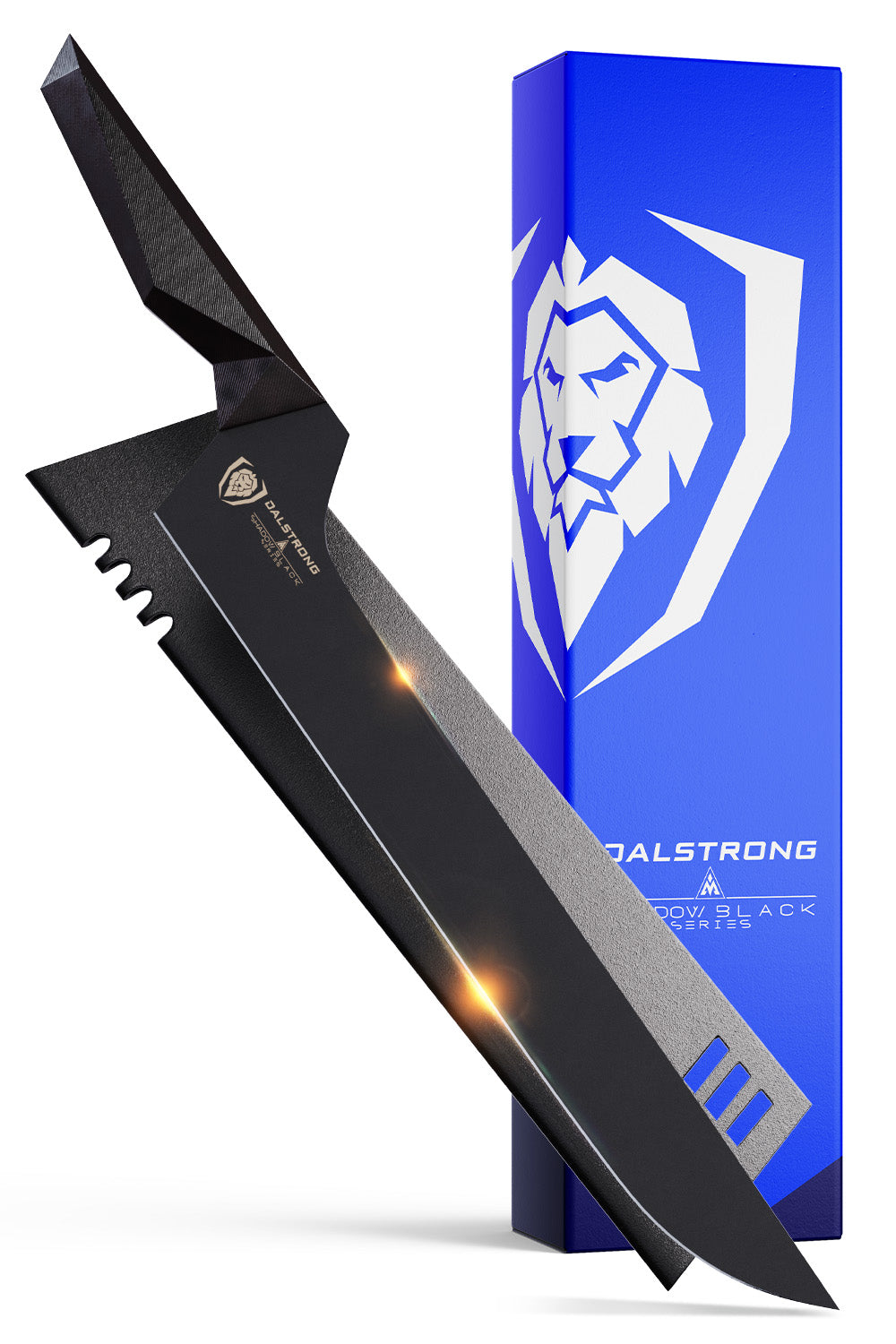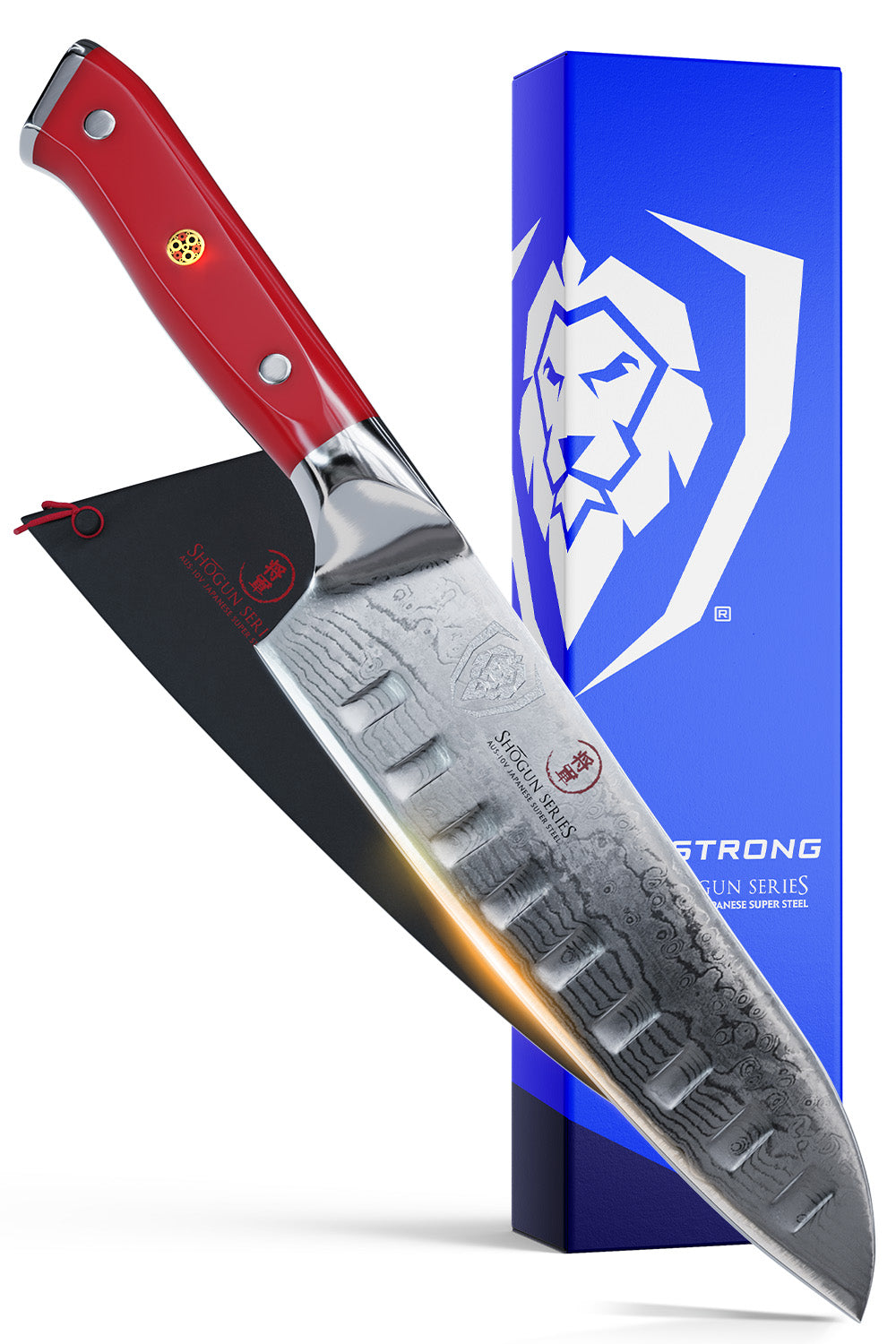 Teak Cutting BoardLarge Size | Horizontal Grain | Dalstrong
Teak Cutting BoardLarge Size | Horizontal Grain | Dalstrong
Quick Overview: How To Check The Internal Temperature Of Turkey
- Insert a meat thermometer in the turkey’s thigh.
- Close the oven door while you read the temperature.
- Make sure the thermometer is not touching any bones.
- The turkey is done when the internal temperature reads 165°F or higher in the thigh.
- Rest your turkey for 30-45 minutes before carving.
I love turkey and you probably do too, if you got here. While there are many recipes for turkey, from the traditional Thanksgiving turkey to summer gourmet twists; they will all require you to get your internal temperatures and doneness right.
There are a few important things to remember when cooking and serving turkey, but other than that, it is not complicated. So read on to ensure you cook the perfect turkey for that special dinner!
 Bull Nose Butcher Knife 8"Shogun Series | Dalstrong ©
Bull Nose Butcher Knife 8"Shogun Series | Dalstrong ©
1. Turkey Doneness Temperature Chart
Cooking turkey to a perfect doneness level is not only important for a delicious meal; but it’s also a matter of health. The ideal balance between time and temperature guarantees that there are no bacteria or pathogens that could be dangerous to you or your loved ones (for example, salmonella).
The United States Department of Agriculture, better known as the USDA, has published a chart trying to make the matter of “food safety” a bit simpler when it comes to poultry and meat.
Below are the internal temperatures the turkey must achieve and for how long, in order to be safe. Following this guide, the reduction of potential bacteria in turkey is significant (reportedly, only one of every 10,000,000 bacteria will survive if you follow the chart).
|
Temperature |
Time |
|
136°F |
65.3 minutes |
|
140°F |
29 minutes |
|
145°F |
10.8 minutes |
|
150°F |
3.7 minutes |
|
155°F |
1.2 minutes |
|
160°F |
26.1 seconds |
|
165°F |
Instant |
One very important thing to remember is that turkey and other meats continue to cook after you pull them out of the oven or smoker. This time you’re letting the turkey rest before carving is an essential part of a safe turkey cooking process.
2. Steps and Tricks To Check The Internal Temperature Of Turkey
Here are the most important things to remember when checking the internal temperature of turkey:
- The internal temperature of the turkey should be 165°F in the thigh.
- The best way to check the turkey’s temperature is using an instant-read thermometer. Sure, there are some other tricks you can use, but this is the most accurate, safest way to do it. This applies to any recipe which includes meat.
- Always check the temperature in the thickest part of the turkey’s thigh. Because the thigh meat is the part of the turkey that takes the longest to cook, if the temperature is right here, then the rest of the turkey is also done and safe to eat. The thigh is where the drumstick meets the body of the turkey.
- Make sure the meat thermometer doesn't touch any bones, or you may get an inaccurate reading.
- Close the oven door when you’re checking the temperature so it doesn’t lose heat, in case you need to put it back in.
- If the internal temperature in the thigh is not at 165°F, then take the turkey back to the oven racks and check again after 20 minutes.
- If the internal temperature has reached 165°F (remember: in the thigh!) remove turkey from the oven, it is done! However…
- …It is not yet ready to be carved! The resting time is very important and should be anywhere between 30 and 45 minutes. This allows the juices to be absorbed and also, the turkey keeps cooking during this time (it is called “carryover cooking”)
- It is normal that the turkey’s meat shows a bit of pink. This is caused by a red pigment called myoglobin that is present in its muscles. If the meat looks pinkish but the temperature reading is right, trust the thermometer!
IF YOU DON’T HAVE A THERMOMETER...
Even though nowadays it is possible to get a suitable meat thermometer rather easily and affordable, I’m not going to question the reasons why you want to roast a turkey without a thermometer.
I’m just going to remind you, one more time before giving you alternatives, that a meat thermometer is -by far- the best and safest way to check a turkey’s temperature for doneness.
Now, another way you can check the turkey for doneness is to observe the juices. These juices should run clear by all means. Use a knife to poke and press in different parts of the turkey. The liquids flowing should be completely transparent, if you see a bit of red or blood, it’s not cooked just yet.
3. How Long To Cook A Turkey
First, we are going to establish that the recommended oven temperature for roasting the turkey is 325 degrees Fahrenheit in all cases. This temperature has proven to be ideal for the juices to distribute well and the meat to cook nicely (given that the turkey is fully thawed).
This safe temperature, however, is based on an unstuffed turkey recipe. Stuffed turkeys have different instructions.
This chart is a perfect guide for the turkey weight-cooking times ratio (roasted at 325 degrees).
|
Turkey’s Weight |
Cooking Times |
|
12-14 lbs |
3 to 3.5 hours |
|
14-16 lbs |
3.5 to 4 hours |
|
16-18 lbs |
4 to 4.5 hours |
|
18-20 lbs |
4.5 to -5 hours |
4. How To Safely Handle, Prepare, And Store Turkey
Thawing Turkey Safely:
You can thaw your turkey safely using several methods.
- Thaw it in the refrigerator for around 24 hours for each 4-5 pounds. Put a container underneath in case there are any juices or drippings. The thawed turkey can stay in the refrigerator for up to 2 days before cooking.
- Thaw it in cold water, inside a plastic bag. It should be completely covered, around half an hour for each pound of turkey. Change the water every 30 minutes or so. It must be cooked immediately.
- Not recommended but possible: thaw the turkey in the microwave, following the manufacturer’s instructions.
Handling and Preparing Turkey:
- Wash your hands thoroughly before and after handling the turkey. Raw turkey can propagate germs through your hands.
- If you are cooking several sides or foods, use separate cutting boards for raw turkey and for carving the turkey.
- Wash every item or utensil that came in contact with raw turkey like cutlery, cutting boards, etc. after preparation.
- Do not wash raw turkey! The juices run and can contaminate other foods and surfaces.
- Cook your turkey safely and thoroughly following the cooking tips and the temperature/turkey cooking times in this article.
Storing Turkey:
- Keep raw frozen turkey in the freezer until you want to thaw it.
- Keep fresh raw turkey in the refrigerator (only 1 day or 2).
- Cooked turkey should be divided into pieces and stored in the refrigerator (3-4 days) or in the freezer (up to four months)
- Refrigerate cooked turkey within 2 hours after cooking.
- Leftovers should be reheated to at least 165°F before consumption.
5. Tools You Need To Enjoy Your Perfectly Roasted Turkey
1. Carving Knife & Fork Set 9" | Crusader Series
The elements in this carving set have the shape, size and functionality to work a turkey with expertise and precision, but also, elegance. Undoubtedly, this set is also an ally when carving all types of roasts like poultry, beef, or pork.
PROS:
- The sharp carving knife will slice cleanly through the meat, and even the bones and joints.
- The special carving fork will hold the turkey steady while carving (so much better than a regular kitchen fork).
- German high carbon steel at 58+ Rockwell guarantees hardness and edge retention.
- Modern minimalist design in high chrome stainless steel.
- Easy to clean and low residue build-up.
- The set includes a sheath to protect the knife, and your hands.
- Excellent quality at a good price.
- NSF certified.
CONS:
- Many will prefer a more classic design for their knives.
- Some people (my mom included) prefer the grip of a classic wooden handle.
2. Carving Knife & Fork Set 9" | Shogun Series
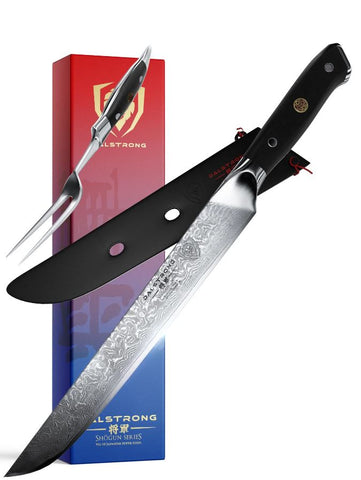
Maneuverability, beauty and fluidity characterize this Shogun Series magnificent set, including a carving knife and carving fork. Carve your turkey effortlessly like butter: smooth, clean and with minimal resistance. You will soon be looking for excuses to use and show this set.
PROS:
- The 9" knife is forged from Japanese super steel and built with 66 layers of high-carbon stainless steel.
- The edge angle of 8-12º per side ensures precision and superb edge retention.
- Both the knife and the fork feature ergonomic, waterproof handles made of ultra-premium G-10 Garolite.
- Breathtakingly beautiful, engraved blade.
CONS:
- If you're looking for la crème de la crème, this is it. But if you were looking for the most affordable solution, there are other suitable tools at a lower price.
- The shogun series has a mystique design, and you may be looking for something a bit more ‘occidental’.
3. Slicing & Carving Knife 12" | Quantum 1 Series
A state-of-the-art knife to perform from the most traditional to the most challenging tasks. With this innovative 12-inch knife, you can carve and slice any turkey, roast, chicken, ham and anything else in your culinary journey.
PROS:
- Ultra-premium American-made hyper steel.
- Nitrogen treatment to increase hardness, flexibility and strength.
- The "Nova Prime" pattern reduces food drag.
- Innovative Dragon Skin handle pattern for greater control.
- It comes with a Leather Carbon-Fiber Sheath.
CONS:
- If you are not used to this blade length, you may need some time to maneuver it with confidence.
- The handle design can feel too different for home cooks with more conservative tastes.
4. Chef's Knife 8" | Phantom Series
If you don't have a carving knife, and you don’t want to buy one just for this one occasion; but rather acquire a tool that can help you navigate this and any other adventure in the kitchen; then we recommend you get a sharp chef's knife like this 8" one from the Phantom Series. Performance and versatility at their peak.
PROS:
- This knife with a Japanese D-shaped handle allows you to have firm control without limiting hand movement.
- Slice, dice, cut and carve almost anything with this blade.
- Premium Japanese steel.
- Elegant and refined design.
CONS:
- Some may prefer a wider blade.
- Perfectly suitable for carving a turkey, but it is not designed specially for this end, like it is the case with a carving knife.
5. Teak Cutting Board | Large | Horizontal Grain

You will need an appropriate cutting surface to carve a turkey, and it may be just as important as a carving knife. But this is not just any surface. This large cutting board is perfect for everything, from the most mundane to the most demanding cutting tasks.
PROS:
- Its large size can accommodate a turkey and allows you to work a turkey safely.
- It will not move or put your hands in danger while you maneuver your roast.
- Teak wood ensures a naturally hygienic, safe and highly durable cutting surface.
- The juice groove will collect any juices from your roasted turkey.
- It can double as a fancy serving board.
- Great value for money.
CONS:
- There is a smaller version in case you don’t have too much countertop space (although we recommend a large one for a turkey-carving situation).
- It’s easy to clean and maintain, but not maintenance-free: you’ll need to wash it by hand (never the dishwasher) and treat it with mineral oil once in a while.
6. Frequently Asked Questions About Cooking Turkey
What should be the internal temperature of a turkey breast?
If you’re cooking a turkey breast instead of a whole turkey, make sure it registers 165°F at the thickest point of the breast meat.
What can you cook with turkey?
Turkey recipes are not only for Thanksgiving! Turkey can be used for any dinner recipes, lunch recipes, even breakfast and brunch recipes. Turkey is part of the world cuisine. Enjoy a turkey sandwich, a turkey burger or explore any of the endless turkey recipes!
What is dry-brining?
Dry-brining is a method used to treat turkey and other meats before cooking. It usually involves adding salt and letting the turkey rest for a few hours. The meat will cook juicier and with a wonderful crispy texture.




